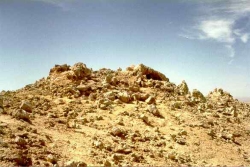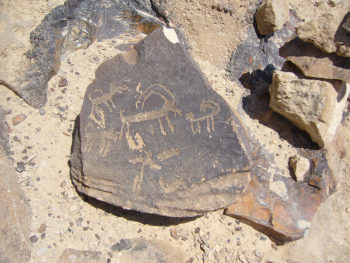
 |

 482x315.jpg) |
| Mi•shᵊkânꞋ ŌꞋhël Mō•eidꞋ (Timna, C. Frank Starmer) |
Now Mōsh•ëhꞋ took the ŌꞋhël and pitched it outside the camp, far from the camp, and called it the ŌꞋhël Mō•eidꞋ. So it was that everyone who made request of é‑‑ä went forth to the ŌꞋhël Mō•eidꞋ, which was outside of the camp.
When Mōsh•ëhꞋ went forth to the ŌꞋhël, all of the am stood-up and stationed himself, each ish by the pëtꞋakh of his ōꞋhël; and they gazed at Mōsh•ëhꞋ until he turned toward the ŌꞋhël.![]()
 |
| incense |
So it was that when Mōsh•ëhꞋ turned toward the ŌꞋhël,![]() the burning incense with its column of smoke
the burning incense with its column of smoke![]() was set down by the pëtꞋakh of the ŌꞋhël, where it sat, issuing incense-smoke, while he would speak with Mōsh•ëhꞋ.
was set down by the pëtꞋakh of the ŌꞋhël, where it sat, issuing incense-smoke, while he would speak with Mōsh•ëhꞋ.
So when all of the am saw the column of smoke![]() standing beside the pëtꞋakh of the ŌꞋhël, all of the am stood-up and then prostrated themselves, each ish by the pëtꞋakh of his ōꞋhël.
standing beside the pëtꞋakh of the ŌꞋhël, all of the am stood-up and then prostrated themselves, each ish by the pëtꞋakh of his ōꞋhël.
Then é‑‑ä spoke to Mōsh•ëhꞋ face-to-face,![]() like an ish will speak with his companion. Then he would return to the camp. But his protégé-minister, the youth Yᵊho•shuꞋa Bin-Nun, didn’t move from inside the ŌꞋhël.
like an ish will speak with his companion. Then he would return to the camp. But his protégé-minister, the youth Yᵊho•shuꞋa Bin-Nun, didn’t move from inside the ŌꞋhël.
“See?!? You told me, ‘Cause this am to make a•liy•âhꞋ!’ But what You haven’t let me know now is who you’re sending with me. Yet, You’ve said, ‘I know you by name, and furthermore, I like
you.’ So, if You like
me, show me Your Ways so I can know You and please You
and—See?—because this goy is Your
am.
“Then He said, ‘My Face
shall go, and I will guide you safely to your destination.
’ ”
”If Your
Face
doesn’t go,” Mōsh•ëhꞋ continued, “then don’t cause us to make a•liy•âhꞋ from here!” How, then, would it be known that You
like
me—me and Your
am? Hal•ōꞋ,
isn’t it in Your
going with us, thereby making us—me and Your
am—distinct from every am that’s on the face
of hâ-a•dâm•âhꞋ?”
And Mōsh•ëhꞋ perceived é‑‑ä telling him,
“I’ll do as you’ve said because I like
you
and I’ve known you
by name.”
”Display,![]() prithee, Your
prithee, Your![]() Kâ•vōdꞋ to me”, Mōsh•ëhꞋ requested.
Kâ•vōdꞋ to me”, Mōsh•ëhꞋ requested.
 |
“I will pass all of My Goodness above your
face
and call in ha-Sheim of é‑‑ä before you.
: ‘Thus I shall be gracious to whom I shall be gracious, and compassionate to whom I shall be compassionate.’
“But you
cannot see My Face
because no living hâ-â•dâmꞋ can see Me. Look,there is a place with Me where you
can position yourself on the summit-bedrock. When My Kâ•vōdꞋ passes, then I’ll put you
in the cleft of the summit-bedrock, and cover you
with My Palm
above you
until I’ve passed. Then I’ll remove My Palm,
and you
may see My Back. But My My Face
won’t be seen.”
And Mōsh•ëhꞋ perceived é‑‑ä telling him,
 |
“Etch two more stone lūkh•ōtꞋ like the first two stone lūkh•ōtꞋ. Then I will write the same words that were on on the first two stone lūkh•ōtꞋ that you broke. So be ready by morning; ascend Har Sin•aiꞋ in the morning and position yourself there on the summit of the har. Not an ish shall ascend with you, nor shall an ish be seen on the entire har. Neither shall the tzōn nor the cattle graze opposite the har.”
So he etched two stone lūkh•ōtꞋ like the first two. Then he got up in the pre-dawn darkness and ascended Har Sin•aiꞋ when é‑‑ä commanded him, and he took the two stone lūkh•ōtꞋ in his hand. Then é‑‑ä![]() descended in the [incense]-cloud and positioned Himself with him there.
descended in the [incense]-cloud and positioned Himself with him there.
Then He called in ha-Sheim é‑‑ä; as é‑‑ä was passing over his face,![]() reciting:
reciting:
“é‑‑ä is é‑‑ä! He is a ra•khūmꞋ and khanūn Eil. He is tolerant,
with great khësꞋëd and ë•mëtꞋ. He is the Nō•tzeirꞋ of khësꞋëd for thousands and the Bearer
of â•wōnꞋ, pëshꞋa and misstepping. When cleansing, He won’t merely cleanse;
rather, He further pō•qeidꞋ the children and grandchildren—even great-grandchildren and great-great-grandchildren—relative to the â•wōnꞋ of the fathers.”
Mōsh•ëhꞋ quickly bowed his head groundward and prostrated himself, saying, “If, prithee, You like![]() me, A•dōn•âiꞋ, and because this am is stiff-necked, prithee, will You go in our midst, forgive our â•wōn•ōtꞋ and our punished-missteps and let us be Your heritage?”
me, A•dōn•âiꞋ, and because this am is stiff-necked, prithee, will You go in our midst, forgive our â•wōn•ōtꞋ and our punished-missteps and let us be Your heritage?”
“I’m here,” He replied, “I Myself carved-out the bᵊrit in front of all of your
am. I will do wonderful things that haven’t been created anywhere in all of hâ-ârꞋëtz or among any of the gōy•imꞋ. All of the am among whom you
dwell shall see the Ma•a•sëhꞋ of é‑‑ä, because what I’m doing
with you
-bᵊrit
-people is awesome.

Optional parental preparation:
33.09 òÇîÌåÌã äÆòÈðÈï, a column of (incense-) smoke-cloud — Although superficial folk assume an ordinary cloud of water vapor, the text doesn’t demand that. In fact, the text describes a column of cloud the descends, quite opposite to the forming of most clouds—which don’t form, or move in, columns either. Moreover, the text describes the cloud-column standing—staying—by the gate of the Tent of Meeting. What cloud does that? Answer: a column of incense-smoke from an incense burner, which, we know from earlier in the text, was present. Simply move it and the cloud-column follows. When a kō•heinꞋ carries it at the front of a marching people, the cloud-column precedes them and the marching people can tell. from far in the back, which way the column may turn when valleys intersect, etc. The people seem to follow the cloud-column. ![]()
![]()
33.11 ôÌÈðÄéí àÆì-ôÌÈðÄéí (face-to-face) — Only nine verses later (Shᵊm•ōtꞋ 33.20), the text informs us that Mōsh•ëhꞋ has NOT seen the Face of é‑‑ä and, indeed, any mortal who might would die. Consequently, superficial interpreters, including rabbinic interpreters, uniformly assume a de rigueur supernatural fairytale that contradicts the reality universe of our Creator. In the real world of Ta•na"khꞋ. Accordingly, we must ask, “What faces, then, were in the tent?” The text answers that question: Mōsh•ëhꞋ and his youth-protégé, Yᵊho•shuꞋa Bin-Nun. These two regularly conferred in a prayerful dialogue to do their mortal human best to discern the Will of é‑‑ä. In this context, they recognized each other in that capacity as two fellow-humans discerning and thereby representing the worldly Interests of é‑‑ä. Ergo, the final decisions were regarded as the only mortal voice that could—must—be regarded as é‑‑ä speaking. And the two prayerfully conferred face-to-face. ![]()
![]()
îÈöÈàúÈ çÅï áÌÀòÅéðÈé and îÈöÈàúÄé çÅï áÌÀòÅéðÆéêÈ — Biblical Hebrew has a verb for “love” and “affection”,![]() but not for “like”. Instead of “like”, Biblical Hebrew distinguishes those who are deemed “favorable” (in someone’s eyes) v all others. The distinction between “finding favor in someone’s eyes” v “like” is notable: in an era when one belonged in his or her niche of a tribal hierarchy, one favored a person regardless of “likability” (due to tribal authority, political, monetary or other considerations). While occasional friction would have been inevitable, tribal authority precluded “likability” being actionable as independent citizens having inalienable rights in modern democracies are accustomed.
but not for “like”. Instead of “like”, Biblical Hebrew distinguishes those who are deemed “favorable” (in someone’s eyes) v all others. The distinction between “finding favor in someone’s eyes” v “like” is notable: in an era when one belonged in his or her niche of a tribal hierarchy, one favored a person regardless of “likability” (due to tribal authority, political, monetary or other considerations). While occasional friction would have been inevitable, tribal authority precluded “likability” being actionable as independent citizens having inalienable rights in modern democracies are accustomed. ![]()
![]()
äÇøÀàÅðÄé (ha•rᵊeiꞋni) — lit. “cause to be seen by me!”, i.e. cause to appear to me! äÇøÀàÅ (ha•rᵊeiꞋ); compound form of hiph•ilꞋ imper. m.s. of øÈàÈä (râ•âhꞋ; he saw) + ðÄé□ (□niy), my, of me, of mine (1st pers. m.s. pronominal suffix).
Since Mōsh•ëhꞋ had been speaking “face-to-face” (v. 11), why does Mōsh•ëhꞋ now ask to be allowed to see Him? And “You cannot see My Face because hâ-â•dâmꞋ cannot see Me while living” (v. 20)? Both of these instances demonstrate that, supernatural and superstitious theanthropism (idolatry) aside, the v. 11 “face-to-face” was conferring with Yᵊho•shuꞋa Bin-Nun, not é‑‑ä!. ![]()
![]()
34.06 – àÆøÆêÀ àÇôÌÇéÄí — long-nosed; a metonym for tolerant, patient, slow to anger. Likely inspired by some king who was known for his long nose and great longanimity, it would seem that ancients associated anger as beginning with the squinting of the eyes and then traveling down the bridge of the nose to flare the nostrils, from whence the anger exploded. This is one idea that could explain the heretofore enigmatic idea that a long nose was associated with a person who was slow to anger, tolerant or patient. ![]()
![]()
34.07 åÀðÇ÷ÌÅä ìÉà éÀðÇ÷ÌÆä To cleanse, he won’t [merely] cleanse… ![]()
![]()
34.10 é‑‑ä addressing “you” in the fem. sing. is peculiar. The only fem. noun in His statement—i.e. to which He could be referring—is bᵊrit; i.e. “you, of the bᵊrit”; not Mōsh•ëhꞋ only but, rather, the am of the bᵊrit. ![]()
![]()
33.21 “My Palm” — Taken literally (as most “religious” do), this would be yet another of numerous examples of a theanthropism (or anthropomorphism), which is prohibited as idolatry. A priori, this can only refer to nimbus clouds in the sky, which obscure visibility—like an enormous palm—heavenward. ![]()
Questions you might anticipate that your child might raise and be prepared to discuss:
What does it mean to “pitch” a tent?
What is a protégé?
![]()
 |
 |